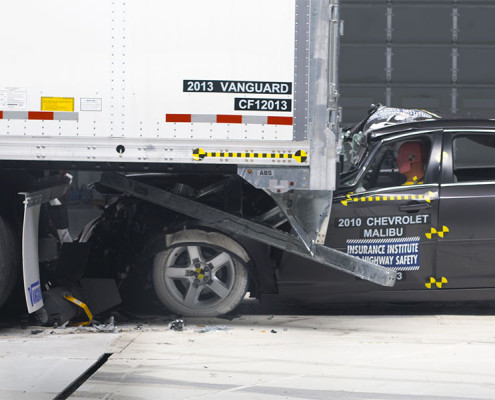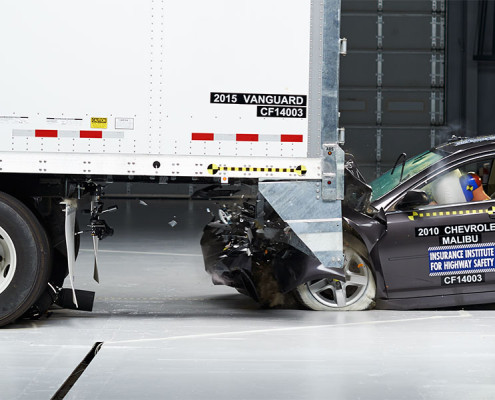Who said trucks are dangerous…
We’ll they are finally getting better. But if you are going to hit the back of a tractor trailer… choose wisely… your life depends on it.
Read this crash test from IIHS.org:
On most crash test days at the Institute’s Vehicle Research Center, a car or SUV races toward a deformable or rigid barrier in a frontal crash. Recently, though, a Vanguard trailer hitched to a parked rig was the target. A 2010 Chevrolet Malibu hurtled toward the trailer at 35 mph, smashing into the outer half of the trailer’s rear underride guard.
Evaluating the Malibu’s crashworthiness wasn’t the goal of the test. Instead, the trailer’s steel underride guard was the focus.
When the test was over, the Malibu ended up behind the trailer — not crushed beneath it — because the Vanguard’s underride guard held up. That’s important because serious injuries and death can occur if a passenger vehicle slides underneath a higher-riding large truck. The Vanguard’s underride guard stopped the oncoming Malibu, preserving survival space for the test dummy in the driver’s seat of the car and preventing the dummy’s head from contacting the rear of the trailer itself. When that happens, injury measures taken from the dummy almost always indicate certain death for a person in a real crash.
“The Vanguard’s underride guard performed great — a big improvement from our earlier tests,” says Sean O’Malley, senior test coordinator for the Institute.
The test is part of an IIHS research program to spur better underride guards that won’t buckle or break away when a trailer gets rear-ended by another vehicle. IIHS trailer crash tests have demonstrated that underride guards need to be stronger than current U.S. safety standards — and in some cases exceed tougher Canadian rules — in order to prevent underride in the kinds of crashes that happen on North American highways (see “Not good enough,” March 14, 2013). U.S. regulators have signaled they are working on a new standard.
Vanguard National Trailer Corp. is among the manufacturers taking the Institute’s findings to heart. The trailer’s passing score is a big win for the Indiana-based company. Two earlier Vanguard models failed prior IIHS 50 percent overlap tests despite complying with U.S. and Canadian regulations.
In an initial test in 2010, the Malibu slid beneath the 2007 model Vanguard trailer as bolts on the rear guard broke and the guard tore off the trailer. The result was moderate underride at 25 mph and severe underride at 35 mph (see “Crash tests demonstrate the need for new underride guard standards,” March 1, 2011).
Vanguard made improvements and requested a second test. When the Institute put the updated 2013 model through another 50 percent overlap test in 2012, the underride guard failed again. The guard’s vertical support broke off the trailer on impact, just as it did in the earlier test (see “Not good enough,” March 14, 2013). The Vanguard was the only trailer of the eight the Institute tested to fail the 50 percent overlap test. Because it failed, the trailer didn’t advance to the next round of 30 percent overlap testing. Only one trailer, a model from Manac, has passed that test so far.
“The Vanguard team is pleased to see a positive result from the recent IIHS test of a new Vanguard rear-impact guard design,” says Charlie Mudd, president of Vanguard National Trailer Corp. “We are always interested in reviewing safety-related options.”
This isn’t the first time IIHS has evaluated an improved design. Hyundai Translead is another manufacturer that made design changes to a trailer and underride guard after at first failing a full-width IIHS crash test in 2010. Two years later the upgraded model built to the tougher Canadian standard passed both the full-width and 50 percent overlap tests. Other manufacturers are working on design improvements to their dry van trailers in response to IIHS evaluations and are expected to request retests.



Leave a Reply
Want to join the discussion?Feel free to contribute!